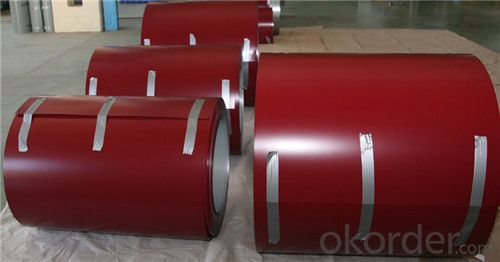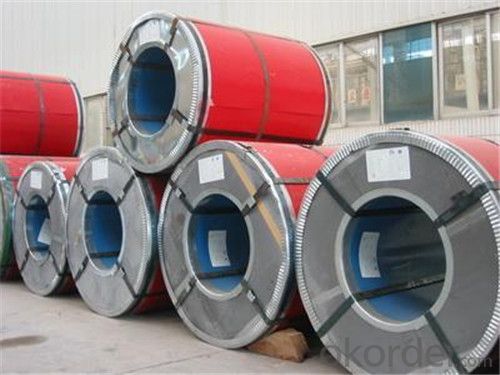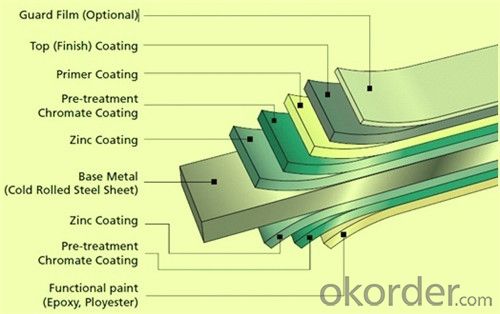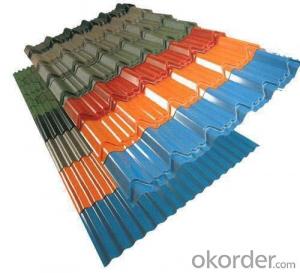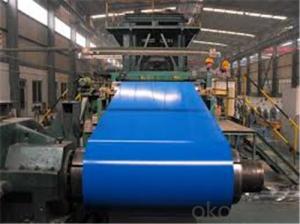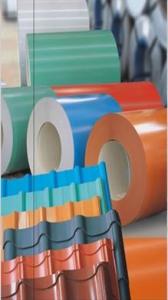Color coated galvanized rolled steel Coils
- Loading Port:
- Shanghai
- Payment Terms:
- TT OR LC
- Min Order Qty:
- 25 m.t.
- Supply Capability:
- 30000 m.t./month
OKorder Service Pledge
OKorder Financial Service
You Might Also Like
Product Description
Brief Introduction
1. Prepainted Galvanized Steel Coil Coil is coated with organic layer, which provides higher anti-corrosion property and a longer lifespan than that of galvanized or galvalume steel sheets.
2. The base metals for Prepainted Galvanized Steel Coil is HDGI steel. The finish coats of Prepainted Galvanized Steel Coil can be classified into groups as follows: polyester, silicon modified polyesters, polyvinylidene fluoride, high-durability polyester, etc.
3. The production process has evolved from one-coating-and-one-baking to double-coating-and-double-baking, and even three-coating-and-three-baking.
4. The color of the Prepainted Galvanized Steel Coil has a very wide selection, like orange, cream-colored, dark sky blue, sea blue, bright red, brick red, ivory white, porcelain blue, etc.
5. The Prepainted Galvanized Steel Coil Coil can also be classified into groups by their surface textures, namely regular prepainted sheets, embossed sheets and printed sheets.
Specification
1. Thickness: 0.3-0.8mm
2. Width: 914-1250mm
3. Inner Diameter: 508mm
4. Weight of Steel Coil: 3-15MT
5. Available Dipped Layer: 50-150g/m2
6. Surface Texture: Normal Coated
7. Type of coating structure: 2/1 Coat the top surface of the steel sheet twice, coat the bottom surface once, and bake the sheet twice.
8. Front Side Paint Thickness: 15-25μm (bottom paint + top paint)
9. Back Side Paint Thickness: 5-10μm
Common performance of front coating
1. Thickness: ≥20μm
2. Pencil Hardness: 2H
3. 60° specular glossiness of coating: >60
4. 180°bend: ≤3T
5. Impact: ≥9J
6. Salt Fog Resistant: ≥500h
7. Color difference: <3ΔE
Application
1. Construction: (Outside) workshop, agricultural warehouse, residential precast unit, corrugated roof, wall, rainwater drainage pipe, terrace, retailer booth, roller shutter door
(Inside) door, doorcase, light steel roof structure, folding screen, ceiling, elevator, stairway, vent gutter
2. Electrical appliance: refrigerator, washer, switch cabinet, instrument cabinet, air conditioning, micro-wave oven, bread maker
3. Furniture: central heating slice, lampshade, chifforobe, desk, bed, locker, bookshelf
4. Carrying trade: exterior decoration of auto and train, clapboard, container, isolation lairage, isolation board
5. Others: writing panel, garbage can, billboard, timekeeper, typewriter, instrument panel, weight sensor, photographic equipment
- Q: I felt that my nylon strings don't sound as good as steel ones. Is it okay that I replace them with steel ones, even if my guitar is classical? Thanks.
- I think so, I've never played classical, only acoustic and electric but my neighbor has a classical and he has all steel strings on it.
- Q: How do steel coils contribute to the marine vessel construction industry?
- The marine vessel construction industry heavily relies on steel coils as vital components. These coils, typically made of high-quality steel, are crucial for fabricating various structural elements of ships and boats. They are utilized in multiple ways to contribute to the construction and functionality of marine vessels. To begin with, steel coils are essential for constructing the hull, which serves as the main body of the ship. Given the harsh conditions at sea, such as waves, corrosion, and impacts, the hull requires strong and durable materials. Steel coils provide the necessary strength and integrity to ensure the structural stability and safety of the vessel. Furthermore, steel coils are utilized in fabricating decks, bulkheads, and other internal structures of marine vessels. These components are vital for dividing the ship into compartments, providing stability, and supporting various equipment and machinery. Steel coils, known for their excellent tensile strength, can bear heavy loads and resist deformation, making them ideal for constructing these crucial elements. In addition, steel coils are employed in the construction of propulsion systems and other mechanical parts of marine vessels. These coils are often shaped and formed into specific components, such as shafts, gears, and propellers, which are essential for the vessel's propulsion and maneuverability. The high strength and durability of steel coils ensure the reliability and efficiency of these mechanical systems, enabling smooth navigation and operation of the vessel. Moreover, steel coils contribute to the marine vessel construction industry by enhancing safety and longevity. Steel is highly resistant to corrosion, a major concern in marine environments due to saltwater exposure. By utilizing steel coils, marine vessels can withstand the corrosive effects of seawater, reducing the need for frequent maintenance and repair. This, in turn, improves the vessel's lifespan and minimizes the risk of accidents or failures at sea. In conclusion, steel coils are indispensable in the marine vessel construction industry. They provide the necessary strength, durability, and resistance to corrosion, ensuring the safety, performance, and longevity of ships and boats. Whether it is the construction of the hull, fabrication of internal structures, or creation of mechanical components, steel coils play a vital role in every aspect of marine vessel construction.
- Q: I saw an amazing flamenco player, however i have a steel string guitar, where he had a nylon stringed one. So i was wndering if its possible to play flamenco songs on the steel string guitar, and where could i find a tab for it? are there tabs for rasegueados?
- Rocket Languages it is a acknowledged leader in online language understanding. With Rocket Language course you will have characteristics like: voice recognition, testing, games, in-built flashcard app and a intriguing design. Rocket Languages is the best option to understand Spanish language.
- Q: How are steel coils used in the production of electrical conduits?
- Several techniques are employed in the production of electrical conduits using steel coils. Firstly, the raw material for manufacturing electrical conduits is steel coils. These coils are composed of specially processed and formed high-quality steel, which is transformed into a continuous strip of considerable length. Once the steel coils are acquired, they are fed into a machine known as a slitter. This machine swiftly slices the coils into narrower strips of the desired width, which will function as the foundational material for the electrical conduits. The subsequent step involves shaping the steel strips into the desired conduit shape. This is accomplished by guiding the strips through a series of rollers and various shaping tools. Gradually, the steel strips take on the round or rectangular shape of the conduit as the rollers exert pressure and manipulate the strip until it reaches the desired form. After the shaping process, the ends of the steel strips are fused together to create a seamless conduit. This welding procedure ensures that the conduit possesses a structure devoid of any seams, a vital characteristic for its functionality and durability. Once the conduits have been shaped and welded, they undergo additional processing to enhance their properties. This may involve galvanizing, whereby a protective layer of zinc is applied to the conduits to shield them from corrosion. This additional layer significantly prolongs the lifespan of the conduits, rendering them suitable for a wide range of electrical applications. In summary, steel coils play a crucial role in the production of electrical conduits. These coils serve as the raw material that is shaped, welded, and further processed to create the final product. The utilization of steel coils ensures that the electrical conduits are robust, long-lasting, and capable of withstanding the rigorous demands of electrical installations.
- Q: What is the thickness of a steel coil?
- The thickness of a steel coil can vary depending on the specific requirements and application. Typically, the thickness of a steel coil can range from a few millimeters to several centimeters.
- Q: How are steel coils protected against moisture and humidity?
- Steel coils are protected against moisture and humidity through a variety of methods. One common method is the application of a protective coating on the surface of the steel. This coating acts as a barrier, preventing moisture from coming into direct contact with the steel surface. Coatings can be made of various materials such as paint, zinc, or other corrosion-resistant substances. In addition to coatings, steel coils are often wrapped in a moisture-resistant material such as plastic or waxed paper. This wrapping provides an extra layer of protection, preventing moisture from seeping into the coils during storage or transportation. Furthermore, steel coils are typically stored in a controlled environment with controlled humidity levels. This helps to minimize the chances of moisture condensation on the surface of the coils. Storage facilities may also utilize dehumidifiers or other moisture control measures to maintain optimal conditions. Lastly, proper handling and transportation practices are crucial in ensuring the protection of steel coils against moisture and humidity. Special care is taken to avoid exposing the coils to rain or excessive humidity during loading, unloading, and transportation processes. By employing these various protective measures, steel coils can be effectively safeguarded against moisture and humidity, reducing the risk of corrosion and maintaining their quality and integrity.
- Q: How are steel coils used in the manufacturing of elevator components?
- Steel coils are used in the manufacturing of elevator components as they provide the necessary strength and durability required for various parts such as brackets, frames, and shafts. The coils are shaped, cut, and welded to create the desired elevator components, ensuring a sturdy and reliable structure that can withstand heavy loads and constant usage.
- Q: Can steel coils be used in high-temperature applications?
- Yes, steel coils can be used in high-temperature applications. Steel has excellent heat resistance properties, and it can withstand high temperatures without undergoing significant deformation or structural damage. Additionally, steel coils are often treated with coatings or alloys to enhance their heat resistance, making them suitable for various high-temperature environments such as furnaces, boilers, and industrial ovens.
- Q: How are steel coils used in the manufacturing of tubes?
- Steel coils are used in the manufacturing of tubes by being unwound and fed through a tube mill where they are shaped and welded together to form seamless or welded tubes.
- Q: What material is strongest? Human bone, steel, or concrete?
- Steel is used to shape and reinforce concrete. Steel is also used in cutting bones in surgery and repairing bone through use of steel pins and braces. So, the answer is most definitely steel. In answer to your watch question, the volume of concrete was greater than that of your watch. The question of large volume vs. small volume is an easy one. Ten tons of human bone would easily reduce a 1 lb block of concrete to powder. Likewise, ten tons of concrete would snap a steel bar like a toothpick. Your watch had much less volume than the concrete you dropped it on. Furthermore, with enough force, your watch would have made a hole in the concrete, but its acceleration was not enough to counter the impacting force of the solid concrete reinforced by the soil and clay below it.
Send your message to us
Color coated galvanized rolled steel Coils
- Loading Port:
- Shanghai
- Payment Terms:
- TT OR LC
- Min Order Qty:
- 25 m.t.
- Supply Capability:
- 30000 m.t./month
OKorder Service Pledge
OKorder Financial Service
Similar products
Hot products
Hot Searches
Related keywords





